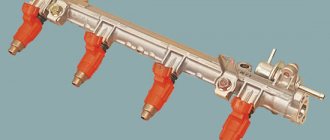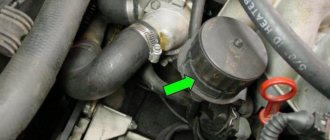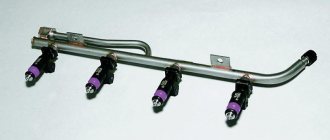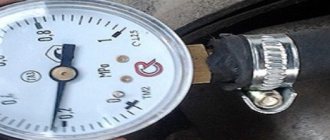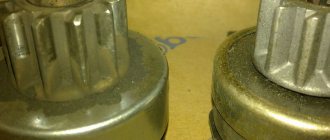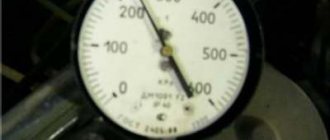For proper and reliable operation of the VAZ 2110 engine, optimal fuel pressure must be maintained in it, and deviations in pressure seriously affect the operation of the entire engine.
Sometimes when a car starts poorly, jerks, or refuses to drive at all, one of the reasons for such malfunctions may be insufficient fuel pressure in the system.
In this article, we will look at ways to check the fuel pressure in the VAZ 2110 ramp, and we will also talk about the nominal pressure in the fuel system and much more.
Fuel pressure in the system
Fuel pressure is one of the important parameters in the car system; the reliability of starting and driving the car depends on it. The pressure is pumped up by a special fuel pump (gasoline pump), which pumps fuel into the rail, and a special fuel pressure regulator dumps excess fuel back into the tank, thereby regulating it.
Parts affecting fuel pressure:
- Fuel pump;
- RTD;
- Filter;
- Injectors;
These parts, if they fail, can reduce fuel pressure.
Types and symptoms of regulator malfunction
The types of RTD malfunctions are as follows. The valve does not hold - fuel begins to circulate freely throughout the fuel system, the pressure in which decreases because of this. As a result, the engine does not have enough fuel when the speed increases, and its power decreases; The pressure in the system should not change after stopping the engine, but since the valve is not able to hold it, when starting the engine, you have to work with the starter for a long time to create the required pressure.
A completely inoperative valve means fuel is not discharged into the tank, and because of this, the pressure in the system increases. As a result, the amount of fuel supplied to the combustion chambers through the injectors increases - there is overconsumption and incomplete combustion of gasoline.
Signs of a faulty RTD are the following engine operation:
- unstable;
- stalls at idle;
- insufficient pickup;
- cannot develop full power;
- the crankshaft rotates at idle speed with a reduced or increased frequency;
- dips and jerks while the machine is moving;
- difficult starting - not always;
- the content of CO and CH in the exhaust gases significantly exceeds the permissible standards;
- excessive consumption of gasoline.
What is the pressure in the fuel system of the VAZ 2110
As you know, the VAZ 2110 was equipped with three types of engines: 8-valve carburetor, 8-valve injection, 16-valve injection. Each of these engines has its own pressure readings, except for the carburetor engine, its fuel is not supplied under pressure.
An 8- and 16-valve injection engine, with an aluminum receiver, that is, with a return line, has a fuel pressure of 2.8-3.2 bar.
A 16-valve engine (124) with a plastic receiver, has no return, the fuel pressure in it is 3.6-4.0 bar.
Measuring pressure using improvised means
Homemade design for measuring pressure in the fuel rail using a conventional tire pressure gauge
It’s easy to measure the pressure using available tools; you just need to have a regular tire pressure gauge on hand (which is used to monitor tire pressure - approx.). All you have to do is follow our instructions exactly. We will tell you how to carry out this operation correctly, and what the correct pressure should be in the fuel rail of the VAZ-2112.
Checking fuel pressure
To check, you need to prepare a special tool, a pressure gauge for measuring air or liquid pressure; connect a hose with a diameter of 12 mm to the pressure gauge through a clamp.
It is advisable to cover the generator with a rag so that fuel does not get on it.
The process of measuring fuel pressure:
- We relieve the fuel pressure by removing the connector from the fuel pump in the system and starting the engine, letting it run until it stops.
- We unscrew the fuel rail cap near the timing belt drive.
- We unscrew the spool.
- We connect the pressure gauge to the fuel rail and tighten it with a clamp.
- Turn on the ignition to activate the fuel pump.
- We check the pressure on the pressure gauge and compare them with the nominal readings.
Troubleshooting
No pressure in the fuel rail? Causes:
- Clogged fuel filter;
- Clogged fuel pump filter;
- Fuel pump malfunction;
- Malfunction of the fuel pressure regulator (FPR). And with high blood pressure too.
If the pressure in the fuel rail gradually drops, the cause may be:
- leaking fuel pump connections;
- leaking injectors;
- fuel pump malfunction.
Let's check it like this. We clamp the leading rubber hose of the fuel rail:
- the pressure has become stable - the fuel module is leaking or the pump is faulty;
- the pressure drops - the injector(s) are leaking.
Checking the RTD. Connect the pressure gauge hose to the outlet fitting of the fuel pump and turn on the ignition:
- the pressure is low but stable - this means the RTD is faulty and is releasing pressure too intensely.
If the pressure in the fuel rail is within normal limits, we look for the causes of engine malfunctions elsewhere.
Keywords: power system Lada Granta | power supply system for Lada Kalina | power supply system for Lada Priora | power supply system for Lada Largus | 4x4 power system | power supply system for Lada Vesta | power system lada xray | Lada Granta engine | Lada Kalina engine | Lada Priora engine | Lada Largus engine | 4x4 engine | Lada Vesta engine | lada xray engine | Niva power system | Niva engine | universal article
0 0 0 0 0 0
Share on social networks:
Spark Plug Inspection
If the spark plugs are wet, then gasoline flows. Dry? In this case, you need to check the signal at the harness connector of the mechanical liquid or gas atomizer (injector) with a probe (as shown in photo 6).
Did you do it, but the spark plugs are still dry? Then you will have to unscrew the screws securing the ramp and lift it under the intake manifold so that the injector nozzles can be seen. We turn on the ignition and turn the engine crankshaft with the starter. If there are no streams of fuel, you need to remove the injectors and most likely replace them with new ones. True, almost every serious service will recommend that you wash them.
If the price of a new set of injectors is slightly higher than flushing, then you should choose a replacement. Injectors also experience age-related problems. Also read:
Replacement
Replacing a fuel pump with a new one requires careful selection of the manufacturer; each pump has its own performance. The absolute leader in this area is BOSCH.
To replace or remove for repair the VAZ 2110 fuel pump we will need: a 17mm wrench, depending on the modification, a 10mm socket, pliers, a flat screwdriver. We remove the rear seat, it is advisable to unscrew the gas tank cap to relieve excess pressure in the system. Disconnect the plastic pump power terminal.
Depending on the modification, we remove the fuel supply and return hoses, or, by pressing the spring clip and pulling the hose, disconnect it from the fuel pump housing. In the second option, use a 17mm wrench to unscrew both fittings and disconnect the tubes.
In both cases, it is necessary to disconnect carefully, since the system is under pressure and when disconnected, the pressure will be released from the injector and a small amount of fuel will leak. If the performance of the old fuel pump is small, there will be no pressure in the system.
Unscrew the 8 nuts from the studs using a 10mm socket and remove the retaining ring with the seal. Carefully pull out the VAZ 2110 fuel pump housing at a slight angle so as not to damage the fuel level sensor; repairing it is unlikely. Using a screwdriver and pliers, remove the lower part of the fuel pump housing and remove the connectors and hoses from the pump. We dismantle the pump.
Assembly is carried out in reverse order. By the way, the original BOSCH fuel pump comes with a mesh. The new fuel pump has high performance, so after replacing it, when you turn on the ignition several times, there will be extraneous sounds when the system is pumped.
Air intake and throttle valve
The first thing we will consider from the design of the VAZ-2110 fuel system (injector, 8 valves) is the air supply. An air purification filter is installed at the inlet - on the “tens” it is made of paper, flat, and has a large surface area. Due to this, filtration occurs as efficiently as possible. The design of the throttle assembly looks like this:
- The pipe through which liquid from the cooling system is supplied to the housing.
- The pipe through which the crankcase is ventilated during idle operation.
- A pipe through which liquid is drained.
- A sensor that allows you to determine the position of the damper when the engine is running.
- Idle air control (you can’t call it a sensor, since the device doesn’t measure anything). This is a simple stepper electric motor that allows you to change the amount of air supplied to the ramp when idling.
- Fitting – necessary for purging the adsorber.
Absorber and its system
Some Lada cars have a fuel system with an absorber. An absorber is an indispensable thing nowadays. It serves to reduce emissions of fuel vapors into the environment.
Absorber
The absorber is a flask filled with special carbon that evaporates fuel vapors and supplies them to the car's receiver. Installed in the vehicle's engine panel.
Absorber sensor
The absorber sensor controls the opening and closing of the air supply to the absorber to control vapors. Installed on the engine cover in engine versions with a volume of 1.6 liters, in engine versions with a volume of 1.5 liters it is installed directly on the absorber flask.
Separator
The separator in Lada cars is installed under the rear left wing near the shock absorber strut and serves to expand the fuel vapor formed in the tank due to temperature changes. Externally, the separator looks like a coolant expansion tank.
Tilting valve
This valve is installed next to the separator under the rear left fender of the car. The valve serves to prevent fuel from entering an overturned car during an accident. That is, when the valve is turned over, it shuts off the fuel system, protecting the car involved in an accident from fire.
Throttle design features
The throttle assembly is attached directly to the receiver. With its help, air is dosed, which enters the intake pipe. A throttle assembly is installed between the inlet pipe (with filter) and the ramp. The damper is connected to the gas pedal via a cable. A sensor is installed on the damper itself; it allows the electronic control unit to determine the position of the damper when the engine is running.
It is worth noting that the fuel system of the VAZ-2110 (16 valves) is approximately the same in design as that of an eight-valve engine. In the flow part of the throttle assembly (immediately before the valve and immediately after it) there are holes that allow vacuum to be removed. With their help, the system responsible for ventilation of the adsorber and crankcase operates. If an adsorber is not installed on the car, the fitting required for purging is closed with a rubber plug. On VAZ-21114 and VAZ-211124 engines there is no channel through which air is supplied to bypass the damper. The connecting flange also has a slightly different shape.

